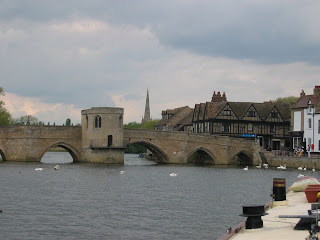 Almost as soon as we went through Brownshill Lock, upstream from Earith, the Great Ouse seemed to change its character. From having been very much a 'fenland' river, with marshy edges contained by man-made flood banks, it transformed itself into a slightly more 'upland' river, not exactly in a valley but flowing through woods, farmland and the occasional village like Holywell, with its thatched cottages. It began to remind us of parts of the upper reaches of the Thames but was less remote. Locks became more frequent and were all self-operated and much smaller than Thames locks.
Almost as soon as we went through Brownshill Lock, upstream from Earith, the Great Ouse seemed to change its character. From having been very much a 'fenland' river, with marshy edges contained by man-made flood banks, it transformed itself into a slightly more 'upland' river, not exactly in a valley but flowing through woods, farmland and the occasional village like Holywell, with its thatched cottages. It began to remind us of parts of the upper reaches of the Thames but was less remote. Locks became more frequent and were all self-operated and much smaller than Thames locks.And then we came to St. Ives! We had heard that the bridge was something special, but it certainly made an impact as the river swung round into the town! Apparently, the chapel on the bridge (dating from 1426) is one of only three bridge chapels in the country -  the other two are in Yorkshire. We walked around the town and visited the little Norris Museum, covered with its sweet-smelling wisteria.
the other two are in Yorkshire. We walked around the town and visited the little Norris Museum, covered with its sweet-smelling wisteria.
 the other two are in Yorkshire. We walked around the town and visited the little Norris Museum, covered with its sweet-smelling wisteria.
the other two are in Yorkshire. We walked around the town and visited the little Norris Museum, covered with its sweet-smelling wisteria.A few days before, we had received a surprise response to an earlier blog entry. One of Jeremy's old schoolfriends from Romford days did a search on the internet which somehow led him to our blog. The next thing was obviously to try to meet up. Dan often visits Peterborough, so arranging to meet us at Huntingdon was not too difficult. We chugged upstream to a very convenient pub, enjoyed a pizza lunch and chugged back to Huntingdon. And, just to prove that he really DID do it, here is a picture of Dan steering 'Zindagi' - and very well too! We look forward to another visit sometime soon.

As we travel on the Great Ouse, we are always on the lookout for suitable overnight moorings, so we were glad to find that there was just enough room for us at a small mooring site near Little Paxton. What we didn't know was that it is right next door to Paxton Pits Nature reserve, and that the local nightingales were in excellent voice! There were plenty of experienced birdwatchers trying to SEE the nightingales, let alone photograph them, so we make no apology for the lack of a picture! We enjoyed being serenaded in the evening and morning. Perhaps they went on all night - we didn't check!
We got another surprise as we came to Willington lock - it was out of action, as some emergency repairs were needed, so we had to wait while the divers sorted it out. No problem, at least it would be done by lunchtime the same day!
And so, maybe a bit quicker than we had thought, we came to Bedford, the limit of navigation - at the moment. There are plans to link the Great Ouse at Bedford with the Grand Union Canal at Milton Keynes. This is not a new idea, apparently, as the original plan dates back to 1811! Explore this link if you want to know more.
On the way back downstream, we found a snug little mooring at Barford Old Mill (the site of a former lock) and were serenaded again by the nightingales at Paxton Pits. We have noticed a gradual increase in the numbers of narrowboats on the river - perhaps more have been following the route through the Middle Level. There seem to be many more fibreglass cruisers based on the river, as on other rivers we have visited, and the increased 'traffic' levels at weekends is very noticeable!
Now we are back in Ely, planning to head up the River Cam in the next few days, visiting some old friends and exploring the Cambridge Lodes.







